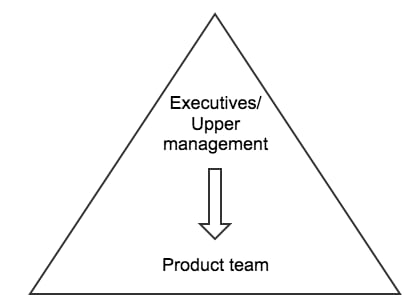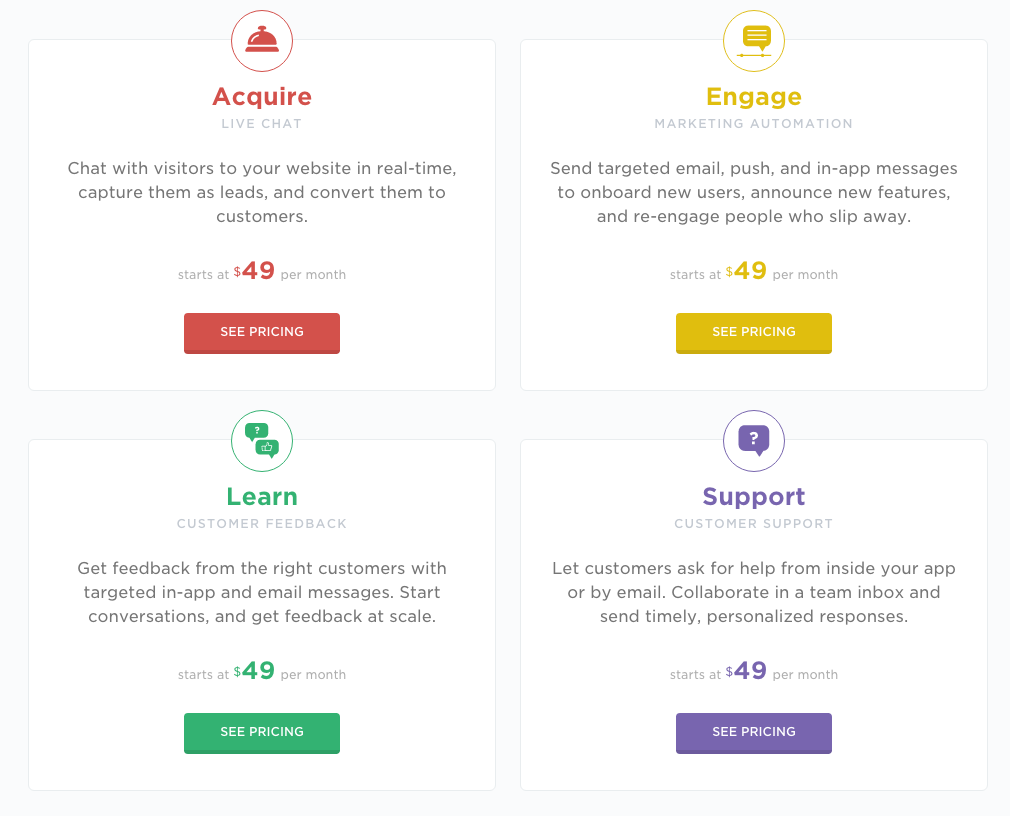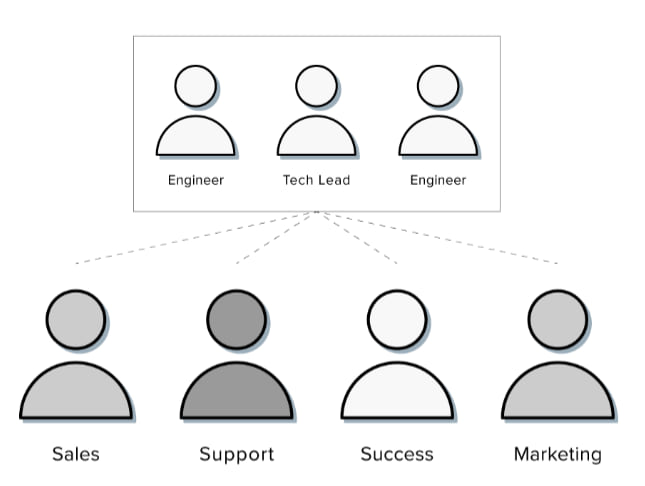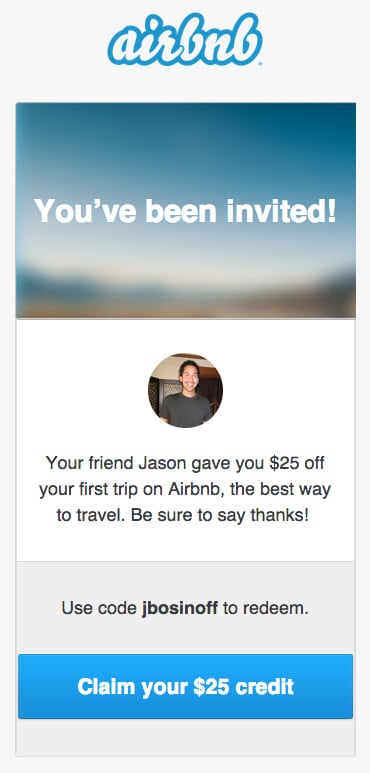How to Build a Customer-Led Product Team
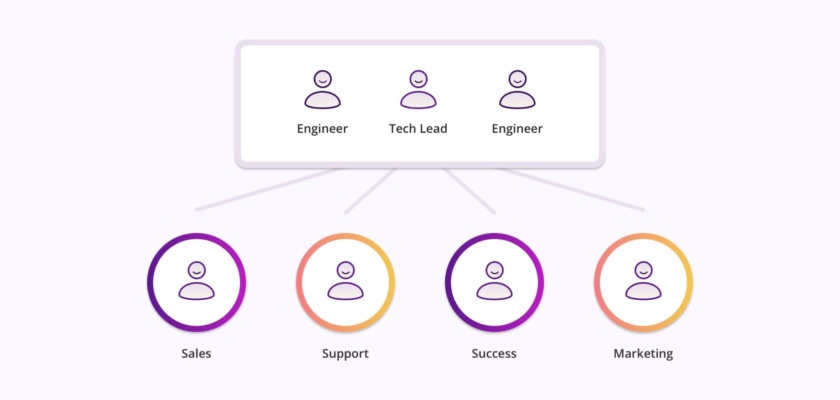
Every product team likes to say that they’re customer-driven. Their company’s mission is all about putting the customer first, and their office is decorated with “customers rule everything around me” posters. It’s easy to pay lip service to being customer-led—but being user-oriented is much harder in practice.
It doesn’t matter what your decor says—truly building around the customer is a function of how your product teams are structured.
To create products that users love, you have to examine and reshuffle your team from the bottom up. By identifying what your current team organization prioritizes, you know what needs to be reoriented to shift your group’s focus to customer needs.
It takes structural change to connect your team with customers. Organized to know exactly what buyers want, your team can iterate their products faster and better.
The Cliff of Customer Experience for Product Teams Today
Every team wants to create products that their customers love — but that’s a daunting task.
You have to balance a multitude of customer inputs across devices, channels, and platforms and implement them into your product development. At the same time, you have to ensure that the product will meet profitable business benchmarks — you can’t offer a reliably outstanding user experience if the product isn’t sustainable.
How your team meets this challenge all depends on your organization. There are typically two different types of product team structures:
- Business-led teams. Product decisions are driven by KPIs to grow revenue and profits.
- Product-led teams. Product decisions are driven by customer inputs to create a superior user experience.
These two types all reflect valuable priorities: monetizing and customer satisfaction. But exclusively focusing on a single one limits your product’s potential. You might have a product concept, for example, that reflects what customers want but isn’t financially feasible. Alternatively, your team might have a product idea that seems profitable based on past products’ revenue, yet doesn’t align with what customers want in user research.
The key is to balance both priorities as a customer-led team. Aligning users’ needs with business goals allows teams to build profitable, customer-oriented products. Serving both interests, companies can sustain their business and continuously provide users with products they love.
To balance both business-driven and user-driven interests, your team has to be restructured. We’ll walk through how each team type can be adjusted to prioritize both areas. With business and user interests all considered, your team will be set up to create products that are both customer-centric and profitable.
We have a secret: this isn’t the full version
This blog post is the condensed version of our analysis of business, product, and customer-led teams.
For the complete read on customer-led teams, download the E-book! It’s complete with thoroughly analyzed examples of each team type and worksheet questions designed to help you understand what type of team you are, and how your team can become more customer-oriented. If we do say so ourselves, it’s pretty great.
Business-led Teams
Generating revenue is critical for product teams. It doesn’t matter how cool or exciting your product concept is — if the product itself leads to losses, it’s not worth developing.
Business-led product teams understand this well. They have a tactical, earnings-driven mindset that often sets their products up for success. By using Key Performance Indicators (KPIs), these product teams can focus on growing the revenue and profits of their products.
With top-down decision-making, upper management at the company controls and approves product development so it’s always aligned with the company’s goals.
This business-driven perspective, however, can also lead products to their downfall. By focusing on KPIs and putting product-decision making in the hands of senior company leadership, business-led teams can be slow to discover and implement the best ways to improve their customers’ product experiences.
Prioritizing metrics and top-down decision making, here’s what a product development workflow might look like in a business-led organization:
- Research. A Product Manager (PM) researches a problem to understand the challenges the customer is facing and how a product might resolve those issues.
- Pitch. With research completed, the PM outlines a plan for developing a product to show to upper management. Senior leadership holds the decision-making power — if the product seems problematic or unlikely to sell, upper management won’t approve the plan.
- Spec. Assuming the product plan is approved, the PM will work with developers and designers on their team to write a product spec, the document that outlines what will be required of the team to build this product.
- Development. Once the spec is complete, the PM, designers, and developers work together to build and iterate on the product. Throughout this development stage, the PM reports back to upper management on the progress of the product.
- Finalize. As the product development finishes, upper management forms insights using the product’s KPIs to decide whether it should be launched.
With this workflow, the business-led product team focuses on stability and profitability. These guiding principles usually lead teams to launch successful products that their buyers love — but not always.
Building around the company’s goals doesn’t always mean you’re being customer-centric. You can’t quickly adapt your product to customer needs because you have to wait for approvals from upper management. Your product development is also disconnected from customers because you’re primarily building around what management wants, rather than what customers need.
Example of a business led team: Blockbuster
Blockbuster is the quintessential example of business-led product development.
Ten years ago, you couldn’t drive through a suburb without seeing the chain somewhere. Blockbuster was the king of video rental stores throughout the 1990s and 2000s — until it was dethroned by Netflix and shut down in 2014.
Blockbuster’s ultimate downfall can be attributed to its business-led product decision-making.
“The board, which were heavily retail-focused, saw embracing online as a threat to Blockbuster’s future as they thought it would cannibalize the high street sales,” said Bryn Owen, ex-Blockbuster UK CMO.
The company judged their product and company based on its past strong performance in stores, assuming customers’ preferences wouldn’t drastically change over time. But we all know what happened next…
Read more about about the Blockbuster business led fail >
Product-led Teams
Today, it’s trendy to be a product-led company. These businesses have an obsessive focus on building a product with a superior customer experience. Product-led companies like Tesla and Facebook have become massive, billion-dollar businesses — and it’s thanks to the strength of their product.
With this mindset, teams improve their product’s customer experience with user-based iteration. Based on inputs from customers, product-led teams decide what features and aspects should be changed and improved. Every product development stage revolves around users’ wants, so the team is always working towards a better customer experience.
Prioritizing users’ feedback enables teams to build products that customers are interested in — but it doesn’t guarantee maximum sales. What the buyer wants isn’t always what drives the most revenue. Consequently, teams that mostly focus on customer inputs can miss out on opportunities to monetize their product.

With this user research focus, here’s what a product development workflow might look like for a product-led team:
- Feedback. The PM uses customer interviews, research, and user behavior data to discover and define the problem that the product is solving.
- Prioritization. The PM presents their product idea to senior product leadership. Product leaders could say no to the idea but, usually, they just offer suggestions about how this product should be improved and help users even more. The PM will incorporate the feedback into the existing product roadmap and prioritize the identified needs.
- Spec. Using product leaders’ feedback and their user research, the PM works with engineers and designers on their team to write a product spec, the document that outlines what will be required of the team to build this product.
- Development. The PM works with designers and engineers to build designs and prototypes of the product, which are tested with users. The PM uses these test results to determine further iterations.
- Finalize. Towards the end of the development process, the PM runs beta versions of the product to get detailed feedback from users. The PM uses this input to finalize the product with designers and engineers before launching it.
With this workflow, a product-led team is always driven by their users.
The product-led team can gather and implement customer inputs to build products that users love. But buyers’ feedback is just a fraction of what’s needed to monetize a product — other stakeholders within a company, such as sales and marketing teams, and business metrics like KPIs should also inform product decisions to ensure that they’re financially sound.
Example of a product led team: Intercom
With 20,000 customers, the enterprise startup focuses on its users by linking their customer service department to product development.
“The customer support team helps us figure out what has to be addressed,” said Paul Adams, the VP of Product at Intercom. “They tag conversations with customers and they make feature requests. They summarize what our customers are telling us.”
Back in 2015, Intercom structured their product in a way that accommodated every user’s need they had come across. A person could choose however many of the four functional plan types they wanted, based on their business’ needs.
Within each type, the customer selected how many people would be using the plan in their company and whether they wanted the Basic or Pro option.
Users were being presented with over 80 product variations between the four types, user amount levels, and the Basic or Pro selection. With this many options, users faced feature analysis paralysis. Unable to make a decision, the user wouldn’t make a purchase, lowering Intercom’s sales.
Continue reading about the harm of being too customer centric >
Customer-led Teams
A customer-led team is the hybrid dream. It takes the best qualities of both business-led and product-led teams to meet users’ needs in a way that aligns with their company’s goals.
Customer-led teams balance the interests of both types — the business-led motivation of profits and the product-led goal of creating a superior user experience. They continuously learn about customers via user research, such as usage analytics and surveys.
Complementing this research, they work with internal teams to figure out how they can meet their customers’ needs in a way that serves their business’ other interests, such as meeting sales quotas or lowering costs. In doing so, they align their users’ interests with the overall goals of their organization.
The dual focus of customer-led teams ultimately serves the customer more than any other team type. Users are served in the short-term as their inputs are implemented in development to build great products. At the same time, users are served in the long-term because these companies, prioritizing business interests, are sustainable and can continually build great products.
The customer-led development process works with user inputs being shared across the entire organization. The product team:
- Collects insights by working closely with customers. Customer-led product teams can make decisions from analyzing user surveys, research, NPS scores, and other customer-based resources.
- Collects and shares customer inputs with internal stakeholders outside of the product team. Discussing customer inputs with other departments allows customer-led teams to also consider business-led concerns in their product development.
Balancing user and business interests, here’s what a product development workflow might look like in a customer-led team.
- Understand the problem. The PM and product team use customer research to understand users’ pain points. From there, they define the problem that the product needs to solve and how it might solve it.
- Company-wide discussion. The PM pitches the idea to product leadership and other company department heads. They provide feedback to the PM on how to create the best product experience for the user while still generating revenue.
- Spec. Using feedback and their user research, the PM works with engineers and designers on their team to write a product spec, the document that outlines what will be required of the team to build this product.
- Speedy iteration. The PM gets early designs and prototypes in front of users to collect feedback, as well as connecting the product team with other internal teams to get input on development.
- Reprioritization. Throughout all of development, but particularly towards the end, the PM reevaluates a team’s progress to ensure that the work is always aligned with the business’ goals and leading to key results by consulting with internal teams about their goals as they relate to the product.
- Finalize. Towards the end of the development process, the PM runs beta versions of the product to get detailed feedback from users. The PM uses this input to finalize the product with designers, engineers, and other internal teams before launching it.
[source]
Involving the entire company, the customer-led workflow is extensive, yet worth it. Considering customer inputs from all perspectives, not just the product team’s view, takes time. But at the cost of slightly slowing down development, the PM and their team can build a product that not only serves users’ interests but also drives revenue and profits for the company.
Example of a customer led team: Airbnb
PMs at Airbnb ensure that both quantitative and qualitative customer inputs are informing development at all stages. For early-stage development and new product development, Airbnb teams rely on user interviews to gain broader insights. In the later stages, usage data is helpful in identifying the smaller feature details that need to be adjusted to avoid roadblocks.
Along with considering customer inputs, product teams are pushed to consider business-driven interests as well. Every quarter, Jonathan Golden, Airbnb’s former Director of Product, conducted a review on each product team to determine their impact on the entire business, not just their individual product goals.
Airbnb’s balance of user-based and business-driven interests can be clearly seen in the launch of Airbnb’s photography program. The launch of the new product satisfied customer needs and grew slumping NYC bookings.
Read more about Airbnb’s perfect product: business balance>
The Key to Being Customer-led? Balance
User-oriented products aren’t created with a single priority in mind — both the customers’ and the business’ interests are considered in development. With this balance, companies have both the user and revenue-based insights they need to sustain their business and continuously provide products that users love.
Shifting your product team to becoming customer-led requires restructuring. Making organizational adjustments with the worksheet questions we’ve provided can refocus your team, allowing it to align customers’ needs with your business’ larger goals.
For the full post, download our customer-led teams E-book.
This blog post is the condensed version of our analysis of business, product, and customer-led teams. The E-book contains thorough examples of each team type and questions designed to help you understand what type of team you are, and how you can become more customer-oriented.

